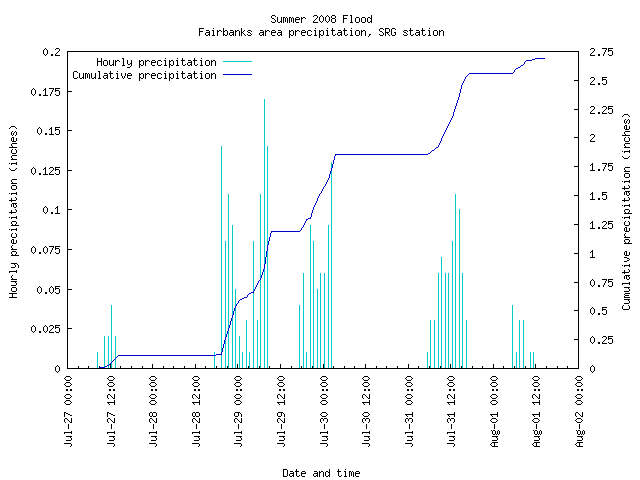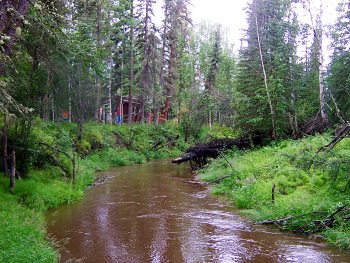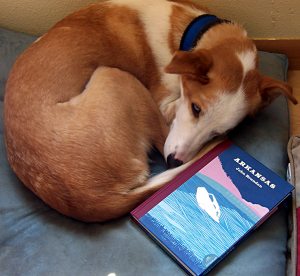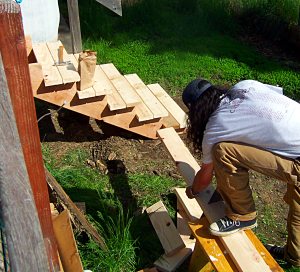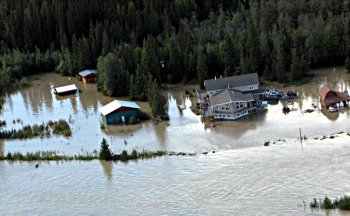
rosie creek flooding
We’ve had four days of nearly constant, heavy rain here in Fairbanks, and the levels of the Interior rivers and streams have come very close to the levels they reached in the Flood of ‘67. So we’re currently experiencing a 30-year flood event. The Tanana, Salcha, Chena and Nenana Rivers have all reached flood stages and many residents in low lying areas near these rivers have been evacuated. The photo on the right, taken by the National Weather Service, shows some of the flooding in the Rosie Creek area. Most of the larger rivers in town are six or seven feet above their normal summer levels.
The following plot shows the hourly and cumulative precipitation from the Small Arms Range (SRGA2) weather station over the past four days. Just under three inches of rain in four days doesn’t sound like a lot when you're from other parts of the country, but Fairbanks gets an average of less than two inches a month in July and August, and our total annual precipitation (including snow) is only 10.87 inches of water. Much of the lower elevation and north-facing areas in the Tanana Valley are permanently frozen and this permafrost is quickly saturated with water. That’s why the region is so lush and green in the summer, despite almost desert-like summer rainfall totals. But once the ground is saturated, there’s nowhere for the water to go except into the streams and rivers. Usually flooding happens during breakup when all the melting snow runs off the frozen ground into the streams and ice jams in the rivers block the flow. Summer floods are more unusual.
Since Labor Day, 2007, we’ve been living around 30 feet away from a small stream, Goldstream Creek, which has risen between four and five feet since last week. If you look at my previous post, the log I’m resting my hand on in the photo is now completely submerged, which means if I were swimming out there today, the water would be over my head. The outside bank has slumped into the Creek in two places, but so far we haven’t lost any trees. The photo to the right shows the current water level, but even with the dramatic rise, it’s quite a bit below what it looked like during breakup this spring.
It’s really exciting living next to something that’s changing all the time like the Creek (plus, Kingfishers!). And now that we seem to have survived a 30-year flood event, I feel a little bit more secure that we’re not going to get inundated in the next high water event.
I’m looking forward to the Tanana Valley Fair, followed by a warmer, and drier August and September.
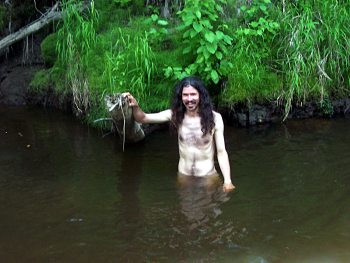
the swimming hole
Once again, I’ve neglected my blog. My new job, the pressures of getting all our work done this summer, and the rest of life has kept me away.
Events: We’ve taken to swimming in the Creek. During the warmth of early June (which hasn’t returned since…) the Creek temperature rose to 65°F, and swimming was actually quite nice. I’m hoping we’ll get a few more warm days before fall so we can swim out there again.
Projects: I’ve made no progress at all on the new shed, but have repaired the bridge and got our digital antenna installed on the roof. I also replaced our chimney cap with the variety our chimney sweep prefers. Things left to do: Build the shed!, repair the glycol line that keeps the septic pipe thawed, fix and insulate the sewage treatment plant discharge pipe, reinforce the shed roofs, obtain and chop two more cords of firewood, install a heat shield behind the wood stove, get curtains for the two large downstairs windows and the sliding glass doors, and (finally) consider hiring a plumbing and heating company to replace and upgrade our system.
Books: I’ve read quite a few. Here’s a summary judgement on each:
- McSweeney’s Quarterly Concern, Volume 26: Enjoyable fictions, interesting format, no real standouts for me.
- The Rest is Noise: Fantastic look at the music and history of the 20th century. Alex Ross is one of my favorite New Yorker writers and this book doesn’t disappoint.
- Ambitious Brew: Interesting history of beer brewing in the United States. It dispels many of the classic beer myths (the most classic being that the big super-brewers ruined American beer, only to be “saved” by the micros), and tells a great story. Prost!
- Let the Northern Lights Erase Your Name: A very enjoyable book with a very memorable female lead. Vida has a great abbreviated and expressive way of writing that was refreshing.
- The Echo Maker: I’ve been looking forward to this one for so long, that I think the reading of it couldn’t be anything but a disappointment. I enjoyed it as a meditation on brain injury, but I felt like the characters were a little overwrought and stiff.
The rest: Andrea continues to progress toward her goal of running the Equinox Marathon. She’s out running sixteen miles (16 miles!) right now. I’m super proud of her. Meanwhile, I’ve been bicycling to work almost every day (13 miles round-trip) and the two of us are working toward doing 100 push ups in six weeks. Maybe by the next photo of me in the Creek, I’ll be ripped.
Probably not…

nika, where to invade next
I wish there were stronger ways than words to express how ruinous George W. Bush has been to our country. From McSweeney’s Where to Invade Next:
So I came back to see him a few weeks later [a few weeks after 9/11], and by that time we were bombing in Afghanistan. I said, ‘Are we still going to war with Iraq?’ And he said, ‘Oh, it’s worse than that.’ He reached over on his desk. He picked up a piece of paper. And he said, ‘I just got this down from upstairs’—meaning the Secretary of Defense’s Office—‘today.’ And he said, ‘This is a memo that describes how we’re going to take out seven countries in five years.’
—General Wesley Clark.
The seven countries Bush, Cheney and Rumsfeld wanted to “take out” are: Iran, Pakistan, Uzbekistan, Venezuela, Syria, Sudan and North Korea. This book, edited by Stephen Elliot lays out the case the Bush Administration would like to have made had their plans in Iraq not gone so horribly wrong (“Mission Accomplished”, jackass). It’s quite sobering reading, because these really are bad places, and in the case of Sudan, something really needs to be done. But most of these countries (all of them?) were made far more dangerous by the invasions of Iraq and Afghanistan, and it’s clear (to me anyway) that this is pretty much our fault. We elected Bush (sort of). Frigging twice (kinda). We elected the Congress that rubber stamped everything he did. We allowed the media to become a corporate shill for the Administration. And now all of the good will we might have had to effect change in the world is lost. To help in Sudan.
Another busy couple weeks, but I did manage to finish John Brandon’s first novel, Arkansas. I wasn’t as impressed with it as I have been with many of the McSweeney’s books introducing new authors, but that’s not to say it wasn’t a good book. It’s about small time crime in Arkansas, and sitting here recalling the characters and plot, it suddenly occurs to me that the Cohen brothers could make a great film out of it. I hadn’t drawn that connection while I was reading it, but now that I’m done I realize the book has a genuine sense of place that’s part of the good Cohen movies, and the two main characters often talk right past each other in a way that reminds me of the characters in Blood Simple. Plus: odd violence that’s not necessarily expected at the time it happens.
It’s probably not going to stick with me the way Icelander or The Children’s Hospital did, but I can certainly recommend it. And not insignificantly, it’s a beautifully produced hardcover with a sewn binding and some nice gold leaf on the cover.
I managed to get a couple projects done this weekend, most notably, a new set of entry stairs for the house. The old stairs were a bit too steep, and the plywood treads were starting to delaminate. I built a new set from 2×12 and 2×6 lumber. The math works like this. You measure the distance from the top surface to the ground and subtract the thickness of material used for the stair treads. The basic rule to help determine the number of stairs for your distance is that the sum of the rise and run for each stair should be around 17". Since I used 2×6’s for the treads, with a small gap in between, the run of each step is 11¼". The distance from the deck to the ground divided by six (one more step than we had before) yielded a rise of 6¼", (6¼ + 11¼ is as close as I can get to 17). Once you’ve got the rise and run numbers, it’s easy to mark out the steps on the 2×12 using a square, remembering to subtract the tread overhang from the run you’re cutting out of the stringers (each notch in my stairs was 6¼" × 10¼" because I have a 1" overhang on each step). Finishing off the stringers means cutting off the top perpendicular to the top tread, and cutting off the bottom so the first rise is the same as the others minus the thickness of the treads. A couple hangers on the deck, a couple concrete piers buried in the ground, and we’ve got a new way into the house.
All hand tools, no electricity was used.
